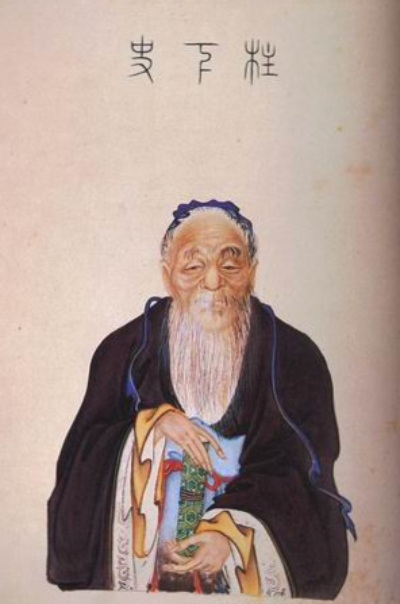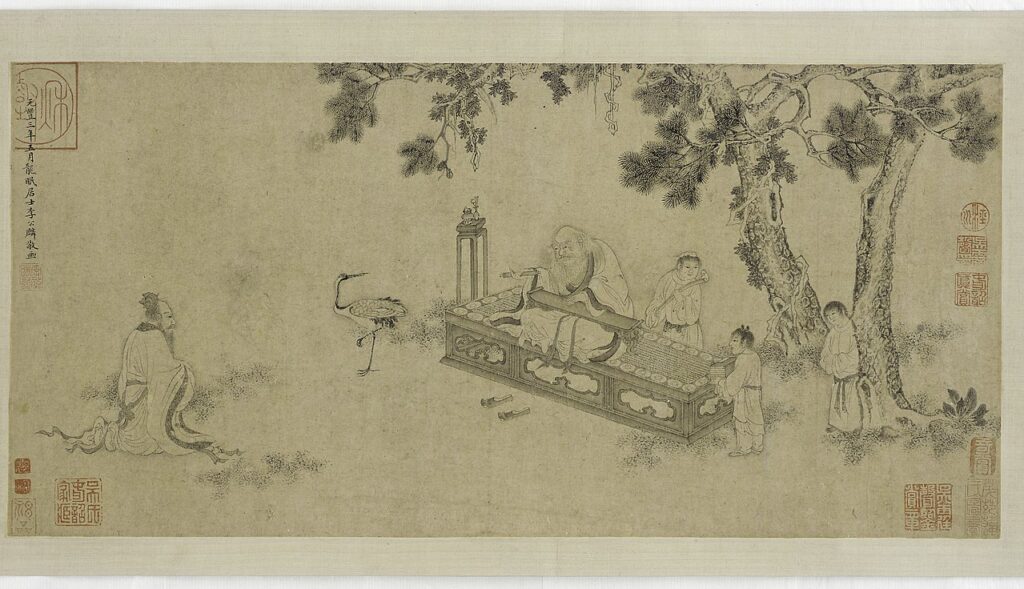
Bent over, you’ll be preserved whole;
When twisted, you’ll be upright;
When hollowed out, you’ll be full;
When worn out, you’ll be renewed;
When you have little, you’ll attain much;
With much, you’ll be confused.
Therefore the Sage holds on to the One and in this way becomes the shepherd of the world.
He does not show himself off; therefore he becomes prominent.
He does not put himself on display; therefore he brightly shines.
He does not brag about himself; therefore he receives credit.
He does not praise his own deeds; therefore he can long endure.
It is only because he does not compete that, therefore, no one is able to compete with him.
The so-called “Bent over you’ll be preserved whole” of the ancients
Was an expression that was really close to it!
Truly “wholeness” will belong to him.
(Translated by Robert Henricks)
Chapter 22 is in many ways typical of the whole Tao Te Ching as it deals with what is known in the West as the “coincidence, or unity of opposites” whereby each act you do, each aspect of your personality, ultimately lead to the emergence of its opposite. While many of us feel intuitively that this is true, do we really understand why this is the case? Some will object that whether we understand it or not does not matter as long as we feel it intuitively. Still, this is far from being part of the experience of most people in the West whose minds have been shaped by the Aristotelian principle of non-contradiction, so it would be great to be able to “explain” why this is so.
Wu ch’eng ’s comment, quoted by Red Pine, will set us up in right direction: “By exploring one side to its limits, we eventually find all sides. By grasping one thing, we eventually encompass the whole. The caterpillar bends in order to straighten itself. A hollow in the group fills with water. The renewal of spring depends on the withering of fall. By having less, it’s easy to have more. By having more it’s easy to become confused.”
It has to do with the relationship between the part and the whole. When you focus on a particular detail, you cannot see the whole picture. “You can’t see the woods for the trees.” And no particular “thing” exists inherently, independently of a broader context. Science now describes it as all things having come about through a self-organising of wholes, which entails that the whole precedes the parts. On the other hand, there can be no whole without parts, just as there can be no parts without a whole.
Ames & Hall explain it philosophically as the “continuity between the focus and its field”: “A major theme that runs through the Daodejing is the continuity between the focus and its field. The ever-shifting focus is constituted by an intrinsic pattern of relationships that locates it within its field of experience. These relationships are dynamic, and function in in a way that can be discerned in the richness and complexity of nature itself. That is, any predicate we use to parse a particular focus will, in the course of the relentless, ineluctable process of transformation, entail its opposite as well. The moon that has waxed full will eventually wane; the stand of cypress that has grown old will gradually be renewed; the star that is burning brightly will in time give itself up to the dark night. That is, a thing can be isolated provisionally as an event punctuated in terms of its present phase, and can also be seen in terms of the process as a whole. This being the case, we understand and function within the field of experience most effectively if we can resist the discriminating and judgmental attitude toward things that comes with a partial view of them, and instead relate to them on the basis of the wholeness implicated within any phase of their process.”
In other words, what we call “things” are in fact temporary and, to some extent, arbitrary, phases of processes. When does the acorn stop being an acorn and begin to be an oak tree? In Buddhism, the unity of opposites is explained by the doctrine of co-dependent origination. Whatever we perceived on the field of our consciousness is the result of a differentiation – like hot and cold, long and short, as well as good and evil, birth and death. Each term includes its opposite, with which it forms a pair united by a “universal” (temperature, size, etc). Daoist sages were not tempted to venture into abstraction since the cultural context in which they operated already had the notion of Dao as two – yin and yang – which drives the qi, which I believe was inherited from the preliterate spiritualities of ancient China. It was therefore possible for these sages to appeal to the experience of concrete manifestations of the unity of opposites. For their disciples and followers, concrete experience was more convincing that abstract theory.
It remains, however, that one will genuinely live in the unity of opposites, only “to the extent to which one is not being fettered by desires.” In other words, the many reiterations of such a unity in the Tao Te Ching should not mislead us into believing that one can, for instance, abstain from “bragging about oneself” in order to “receive credit.” Calculative thought belongs to the ordinary level of reflective consciousness that deals with the “part,” and where desires thrive, not to the wisdom of the sage, who dwells in the whole.
As Alan Chan, presenting Wang Pi’s interpretation of Daoism, explains: “The concept of ‘One’ remains at the center, bridging the transcendence of Tao and the order of the Taoist world. Its natural sense of being the beginning and smallest of all suggests readily – especially in the light of the meaning of wu, which encompasses both “not having” and “not being” … Once the sense of having ‘more’ is linked to the endless ties and longings which render human beings prisoners in their own world, the Taoist calculus of ‘profit and loss’ becomes transparent (chapters 22, 23). Meaningful gain, in this context, can only be measured on a scale of freedom, by the extent to which one is not being fettered by desires … In having less, and this is perhaps the distinctively Taoist contribution, the world is seen to be naturally simple and whole, noncontentious and self-sufficient … To Wang Pi, this speaks more eloquently than any cosmological proof that human nature is modelled after Tao, which is to say ‘true’ and naturally so’, a state of simplicity and wholeness that is realized through nonaction.”
Sources:
Robert G Henricks – Lao-Tzu, Te-Tao Ching
Roger T Ames and David L Hall – A philosophical Translation – Dao De Jing – Making this Life Significant”
Red Pine (Bill Porter) – Lao-tzu’s Taoteching

